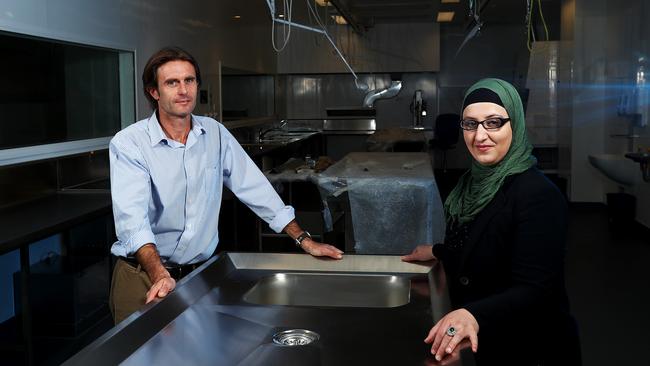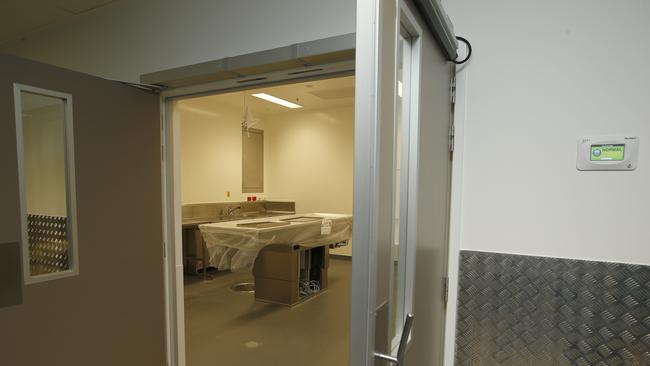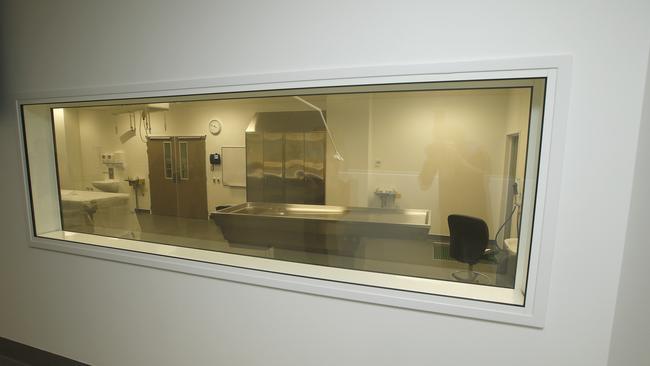Take a look inside the nRAH morgue and meet the faces who work there
WHEN Dzenita Muratovic tells people she works in the Royal Adelaide Hospital morgue by choice, they assume she’s a little strange.

SA News
Don't miss out on the headlines from SA News. Followed categories will be added to My News.
WHEN Dzenita Muratovic tells people she works in the Royal Adelaide Hospital morgue by choice, they assume she’s a little strange.
But behind the face that conducts painstakingly careful autopsies, take away her job title as a medical scientist and she’s also a consoling voice to grieving families.
She’s a counsellor, an organiser, a wife and a mother of two who loves nothing more than finding time to read a good book.
“As a female, I don’t tell people what I do because they look and say that I’m weird,” the 39-year-old says.
“People expect dead people to be walking around like zombies in the morgue (and) usually people are scared of dead people, but I always say ‘Be scared of the living ones, not the dead ones’.
“They ask me if it’s a smelly, bloody or dirty job and, yes, sometimes it can be but I like the scientific part of the job – you have to have an investigative mind.”
The Sunday Mail has beengranted exclusive access inside Mrs Muratovic’s new workplace – the new Royal Adelaide Hospital morgue.
It’s the place many South Australians will end their lives.
Given a morgue is basically a space to hold dead people, many would assume they’re dreary, dark and cold.
Surprisingly, the new morgue is light and bright and nothing like Hollywood depicts.
Located on level one at the nRAH, its walls are white, the bottom half covered with stainless steel sheets for protection against daily wear and tear.
At one end, a small window lets in coveted natural light from an internal courtyard.
A large room with a sofa and chairs is located within the complex for families to wait before they enter a large viewing room, where they can sit and say goodbye to their loved ones.

Two cool rooms, which are kept at temperatures between 2C and 5C, can house up to 38 bodies.
Three large, stainless steel tables occupy a big autopsy room that would be used simultaneously in the event of a state disaster with mass casualties.
A second, smaller autopsy room has negative pressure, needed for conducting autopsies of high-risk patients who had diseases such as HIV, hepatitis or tuberculosis.
The morgue is a busy place, with about 1100 deaths at the hospital every year. That equates to three bodies passing through its doors every day.
Whether it’s someone’s mother, grandpa or brother, a car accident victim or a cancer patient, each and every death is dealt with with dignity.
Bodies wait in the morgue cool room for two to three days on average, before they are collected by funeral directors.
In her nine years working in mortuary, Mrs Muratovic says no two days are the same.
She works in a team of seven specialists under RAH Mortuary Head of Unit Stephen Nygaard, who has worked in the field for 17 years.
“Each autopsy is completely different,” she says, adding they take six hours and the morgue conducts about 30 every year.
“We all have the same organs but we’re all different (and) we will always find something that is completely different from the previous one.

“My initial thought about the job was it was purely scientific but, when you start working, then you find out it is much more than that.
“We often collaborate with social workers but sometimes families call us and ask for advice about what they can do, how to organise the funeral, and my job is to explain the process.
“You have families that are upset and crying – sometimes I have to step in and try to console them and explain everything will be fine, that it will take time to heal.”
When she’s not at work, Mrs Muratovic finds it tough to switch off.
She’s currently completing a PhD in knee osteoarthritis at the University of Adelaide and enjoys spending time with her two boys Imran, 11, and Harun, 7.
“It’s a large part of my life being involved in research – that’s how I relax,” she says.
“If I really have time for myself, I like reading a good book.”
Despite the fact there’s death and dying all around, Mrs Muratovic sees the human life cycle as a thing of beauty.
“In someone’s life you’re born, you live your life and then you finish your life,” she says.
“What you want in a mortuary is that you end your life with dignity.
“When someone passes away, a lot of people think it’s finished, it’s done (but) I find my job is equally as important as saving a life because these families are still acting upon my advice.
“If I could repeat history, I’d always choose this job.”

NRAH MORGUE FAST FACTS
EVERY year, the Royal Adelaide Hospital morgue will house about 1100 bodies.
ABOUT 30 autopsies will be conducted every year, taking six hours each.
THERE is space for up to four autopsies to be conducted at one time, in the event of mass casualties during a disaster.
THERE are two cool rooms in the nRAH morgue that can hold 38 bodies. The old RAH has space for 28.
THE optimum temperature to keep bodies is between 2C and 5C.
USUALLY there are about six to 12 bodies in the morgue.
ON average, a body spends up to three days at the hospital morgue until it is released to funeral directors.
AN additional two bodies can be housed in a third cool room that has a temperature of -20C. This is used for bodies that are kept for more than six weeks due to reasons including family difficulties and financial problems.
THE nRAH morgue includes a new tissue bank that holds donated bone – the most common transplant in Australia after blood transfusions.
FOR the first time in its 28-year history, the bank will be able to mill and supply crushed bone to surgeons, used for a host of operations including older patients with multiple fractures caused by osteoporosis or young children requiring spinal fusion to restore mobility. Currently, surgeons have to order crushed bone for patients from interstate or overseas or prepare it themselves during theatre.
THE new morgue also includes a large viewing room, used for families of loved ones who have died in the hospital.


